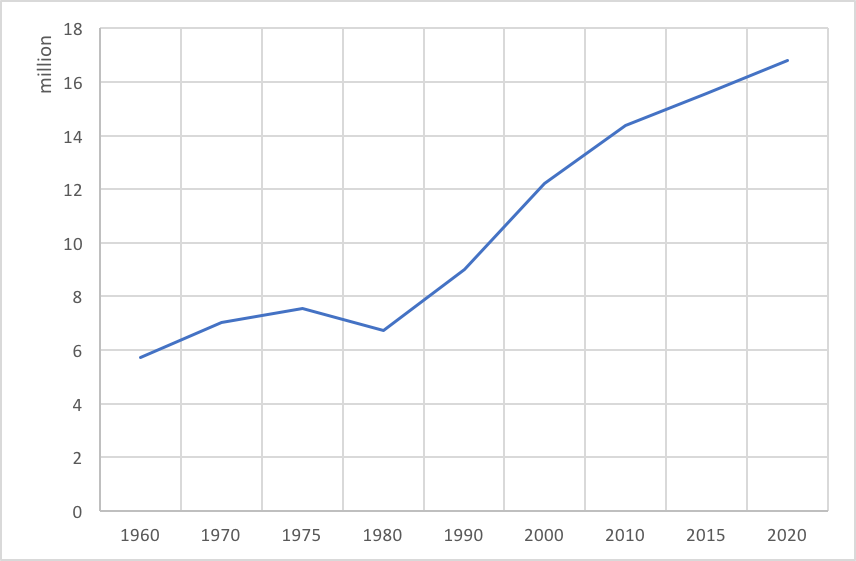Cambodia Basic Information
・Capital Phnom Penh
・Area 18 million ㎢ (about half the size of Japan)
· Currency Cambodian Riel (KHR)
· Religion Buddhism (Some are Muslim)
· Industry Agriculture (30.5% of GDP), Processing Industry (27.1% of GDP), Service industry (42.4% of GDP) (ADB data, 2014)
· Population 16,076,370 (2017)
Cambodia locates in the centre of the Indochinese Peninsula, and it has the Gulf of Thailand in the south, Thailand in the west, Laos in the north, and Vietnam in the east. It’s a 6 to 7 hours flight away from Japan, and the time difference between Japan is 2 hours.
Cambodia is famous for its world heritages such as "Angkor Wat", but the country has a tragic history, such as the genocide of intellectuals under the Pol Pot administration. Although Cambodia had slow economic growth compared to the other ASEAN countries due to the long civil war, it’s getting attention in recent years as the country shows more rapid economic growth by attracting foreign-owned sewing enterprises that seek inexpensive labour force.
More than 90% of the people are Khmer people and Buddhist. Also Cham, Vietnamese, Chinese, and other ethnic minorities who believe in their own religions.
The climate of Cambodia is tropical monsoon climate which has two seasons, the dry season and the rainy season.
Population of Cambodia
Although the population of Cambodia is small, it has been soaring since 1980.Cambodia has the fastest growing population among the ASEAN countries.
Population of Cambodia (Edited the date from World Bank)
(Edited the date from World Bank)
Population by Age
 (United Nations Department of Economic and Social Affairs Popular Division)
(United Nations Department of Economic and Social Affairs Popular Division)
Due to the increase of population after the Pol Pot administration, about 70% people of the population are still younger than 30. A large number of young generation amounting to the workforce is expected to help Cambodian economy to grow.
Cambodian Economy and Policies
Cambodia’s economic growth was lagging due to the long French colonial period, the Vietnam War, and the Pol Pot genocide. In recent years, however, it has gradually recovered with support from other countries and participated in the world’s economy and regional economy by joining ASEAN and WTO.
It is called “Thailand Plus One” along with Myanmar and Laos due to Cambodia's cheap labour costs which are only one-fifth of China and Thailand and a half of Vietnam. Industries that have been driving economic growth in Cambodia are the service industry, in particular tourism, and the manufacturing industry, mostly sewing industry that aims at exporting to overseas.
According to the economic growth rate, the Cambodian economy recorded a high economic growth rate of over 10% from 2004 through 2007 and then declined to 0.1% in 2009 due to the global financial crisis. However, in the following year, it recovered to 6% and is continuing to grow at the average of 7%.
The increase in population is one factor that Cambodian economic is predicted to maintain stable economic growth in the future. In Cambodia, according to the United Nations' population forecast, the labor population will continue to increase until 2070, and the total population will continue to increase until 2020. Also, the fact that the average age of the population is 24, meaning the young working population will be abundant, is expected to contribute to the future growth of Cambodian economy.
Also, national strategic development plan (2014-2018) is being carried out in Cambodia, which aims at agriculture promotion, infrastructure development, and employment creation.
Cambodia Property Investment
A dollar-based transaction is possible in Cambodia. While Riel is the local currency, the US dollar is widely used, and real estate transactions are possible with few restrictions on ownership, payment and remittance in the US dollar.
If you have any questions or would like to arrange a viewing, please feel free to contact us!



![[Area Guide] Cambodia](/_next/image?url=https%3A%2F%2Fsekai-property-post-image.s3-ap-northeast-1.amazonaws.com%2F2253%2Fbaf590f4-3e42-4e46-8da2-d605a1e38247.JPG&w=3840&q=75)




